Warning: pic heavy, as usual. 
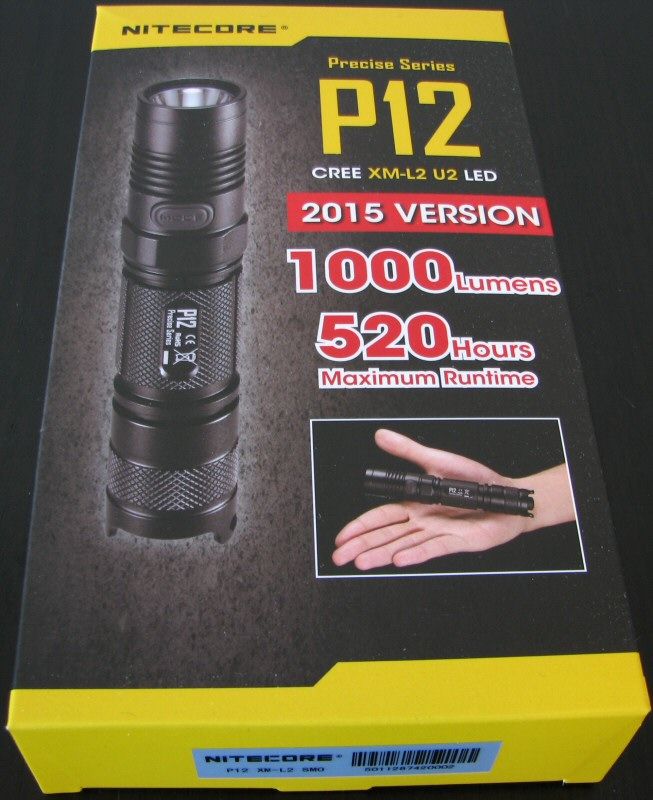
Nitecore has updated their popular P12 model to a new "2015" edition featuring a higher output bin XM-L2 emitter (from T6 to U2). The official specs have been updated to match.
How does this new 2015 model compare to the original 2014 that I reviewed a little while ago? Physically, there is no change in appearance of the light. So let's see what has changed ...
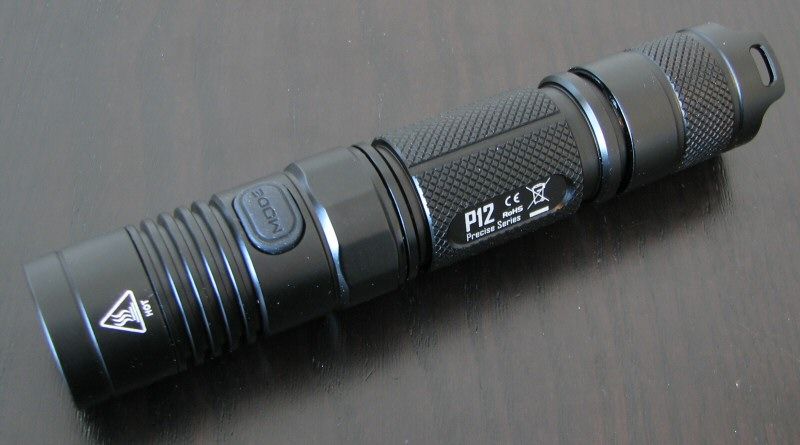
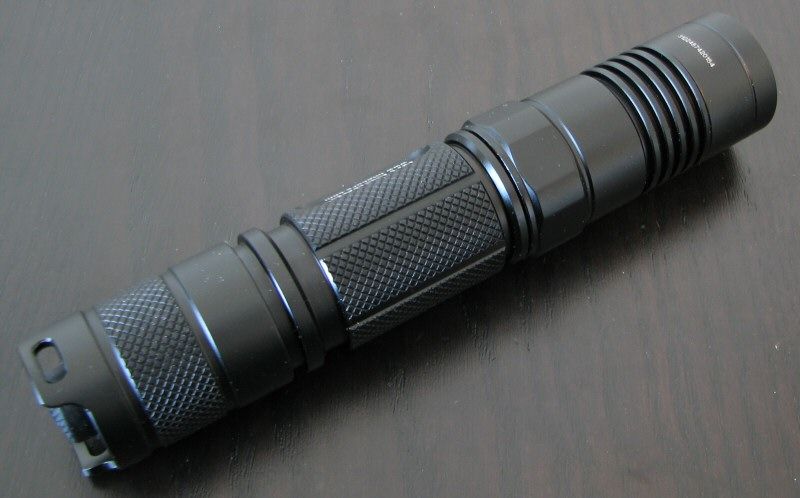
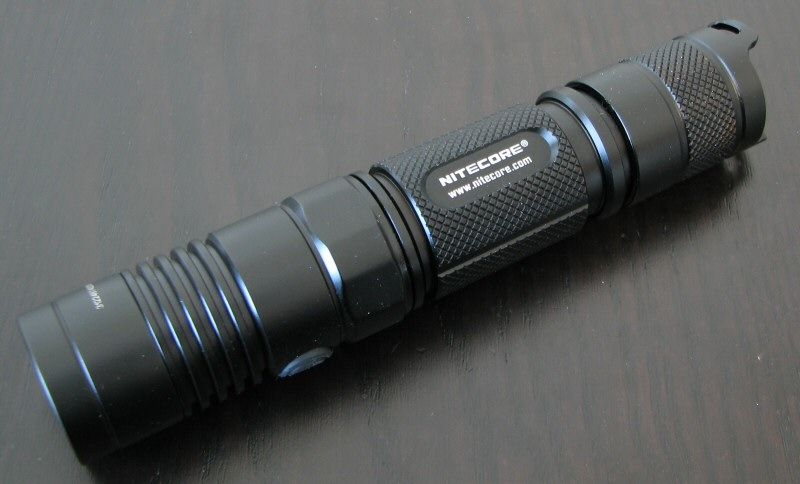
Manufacturer Reported Specifications:
(note: as always, these are simply what the manufacturer provides – scroll down to see my actual testing results).

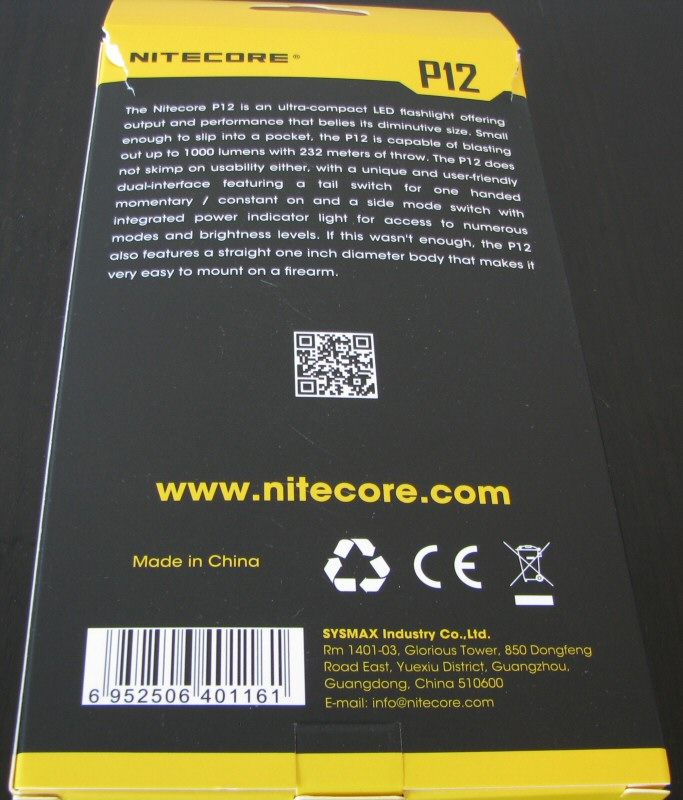
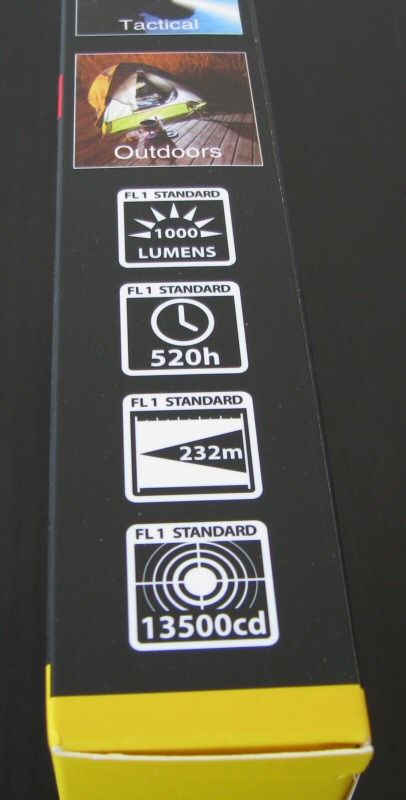
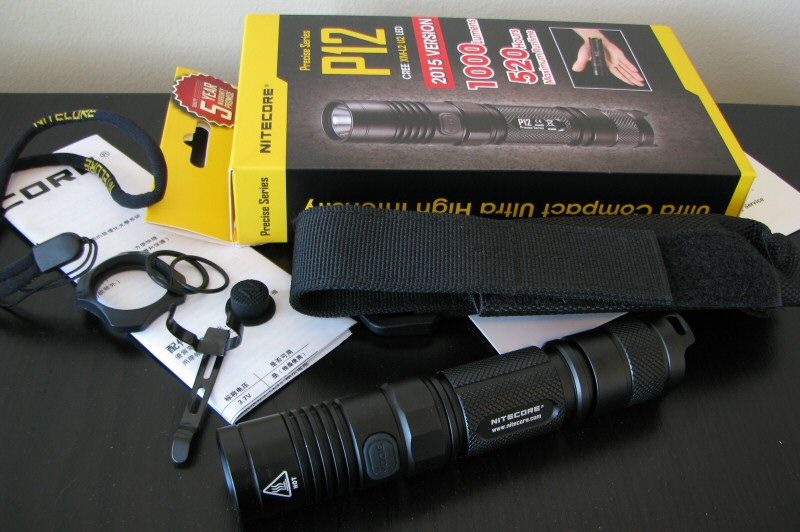
Packaging is the Nitecore's standard thin cardboard display box, with a new 2015 Edition label on the front of the box. As before, detailed specs and information are printed right on the box. Inside, included with the light are spare O-rings, spare tailswitch boot cover, removable grip ring, pocket clip, basic wrist lanyard, holster with Velcro closing flap, product inserts, warranty card, and manual.
Since light looks exactly the same as the previous 2014 edition, I will re-use the body pictures from my 2014 review below.
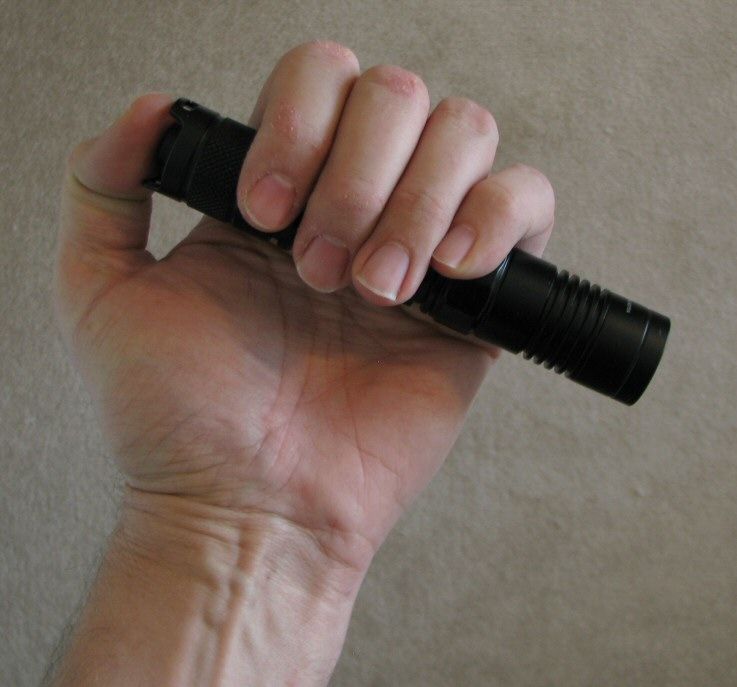
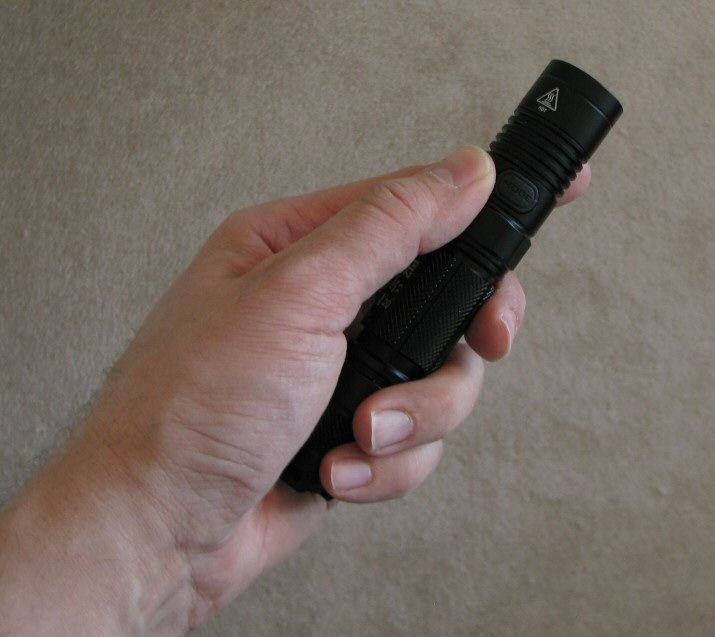
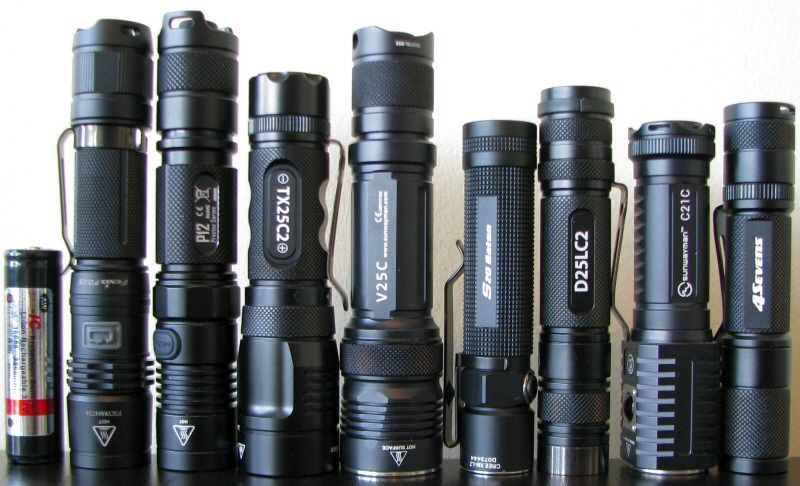
From left to right: AW Protected 18650 2200mAh; Fenix PD35; Nitecore P12; Eagletac TX25C2; Sunwayman V25C; Olight S20 2014; Eagletac D25LC2; Sunwayman C21C; Foursevens Quark Q123-2.
All dimensions directly measured, and given with no batteries installed:
Nitecore P12 2015: Weight: 88.7g, Length: 139.5mm, Width (bezel): 25.5mm
Nitecore P12 2014: Weight: 89.7g, Length: 139.4mm, Width (bezel): 25.4mm
Nitecore P10: Weight 82.0g, Length: 135.1mm, Width (bezel): 25.5mm
Nitecore EC20: Weight: 77.1g, Length: 129.2mm, Width (bezel): 25.4mm
Eagletac D25LC2: Weight: 50.0g, Length: 116.3mm, Width (bezel): 22.5mm
Eagletac TX25C2: Weight 93.6g, Length: 120.4mm, Width (bezel): 31.6mm
Fenix PD35: Weight: 82.7g, Length: 138.1mm, Width (bezel): 25.4mm
Thrunite TN12-2014: Weight: 80.0g, Length: 140.5mm, Width (bezel): 25.4mm
Skilhunt DS20: Weight: 53.8g, Length: 110.0mm, Width (bezel): 24.0mm
Zebralight SC600 II: Weight 79.3g, Length: 101.8mm, Width (bezel) 29.7mm
There is some very minor fluctuation is dimensions between my samples, but I expect that is just normal natural variation.
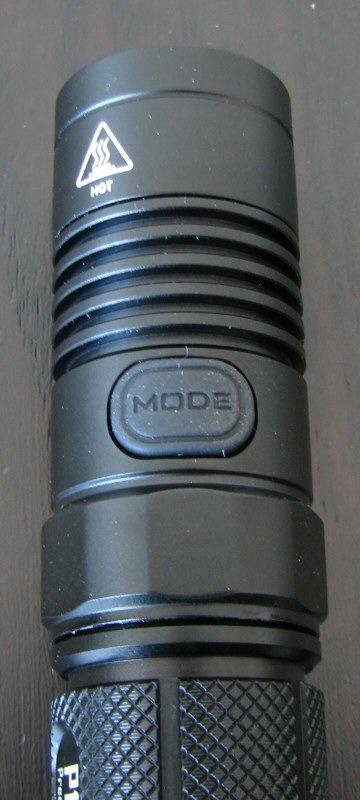
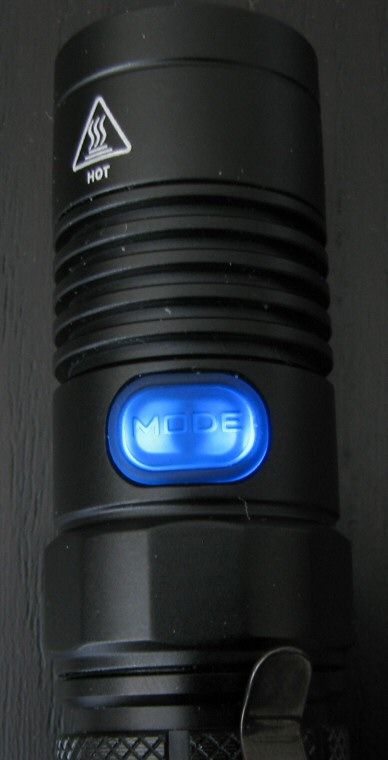
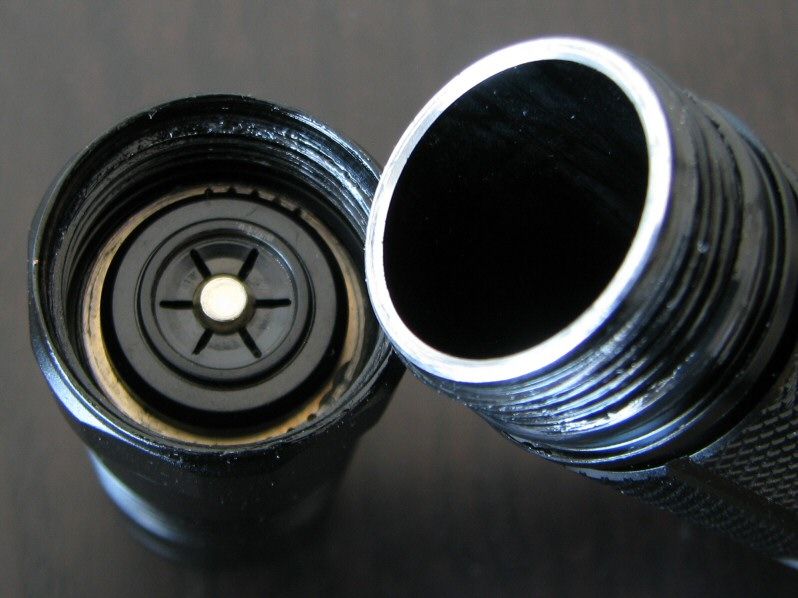
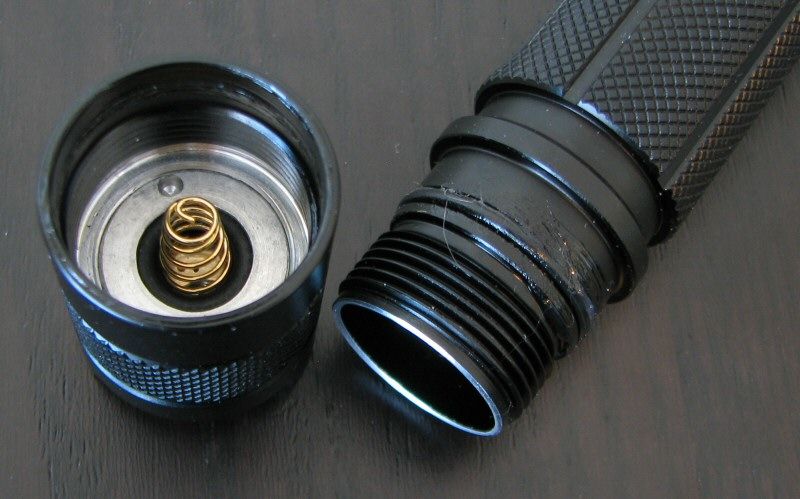
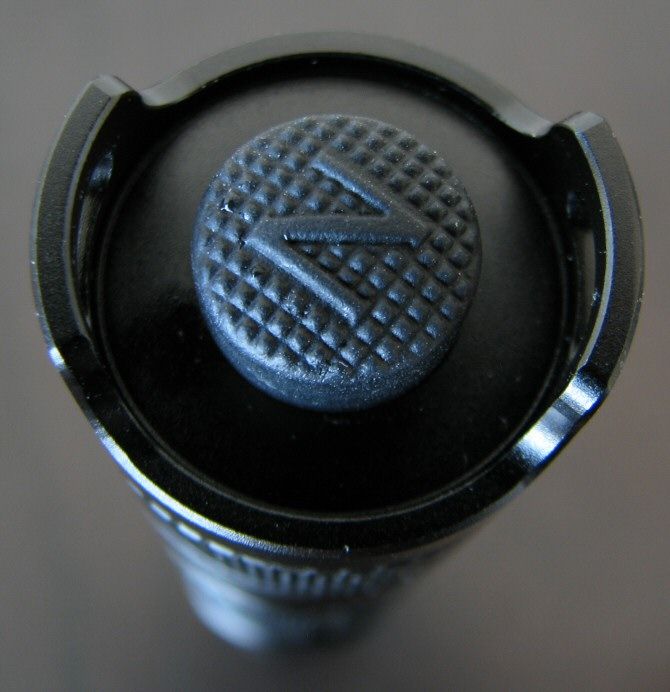
Again, the 2015 edition is physically indistinguishable from the 2014 version. As such, my comments below apply to both versions.
The P12 is a compact, yet solid little light. Anodizing is a shiny black finish, hard anodized, with no chips or damage on my sample. Body labels are bright white and clear against the black background. Knurling is of moderate aggressiveness on the body tube and tailcap. But when combined all the other grip elements (e.g., side switch cover, fins in the head, pocket clip, etc.), I would describe overall grip as very good.
The light has decent anti-roll indentations on the body, but the clip is even more helpful in that regard. Clip is supposedly titanium-plated stainless steel, and feels reasonably sturdy. There is also a bundled grip ring in the package, for cigar-grip style carry (also very effective for anti-roll).
Tailcap screw threads are standard triangular cut and anodized for lock-out at either end of the body tube. :thumbsup:
The P12 uses a forward clicky switch, but with very good tailstanding ability due to the raised side edges (suitable for lanyard attachement). Switch access by finger or thumb is good.
On/off is controlled by the physical tailcap clicky switch, but all mode switching is done by the electronic side switch in the head. The mode-changing switch in the head has pretty good feel for an electronic switch, with typical traverse. It is relatively easy to locate by feel (although could be grippier, with more visual distinctiveness).
Note that like many other Nitecore models, there is a blue LED under the mode-changing side-switch that will glow blue when the batteries are running low. It also serves as a voltage read-out function. Please see my User Interface section for a discussion.
There is a physical reverse polarity feature in the head. However, this has been updated from earlier Nitecore models and now allows "wide button top" cells to work in the light. True flat-tops (where the positive contact is below the wrapper) won't work, but all my cells with a slightly raised contact worked fine.
The body tube is wide enough to accommodate all size 18650 cells, and there seems to be plenty of room of longer cells as well.
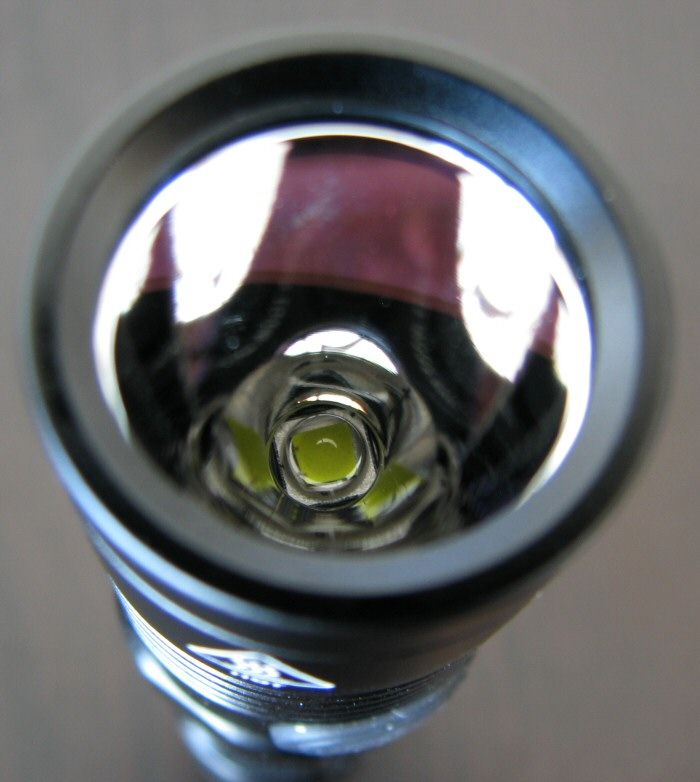
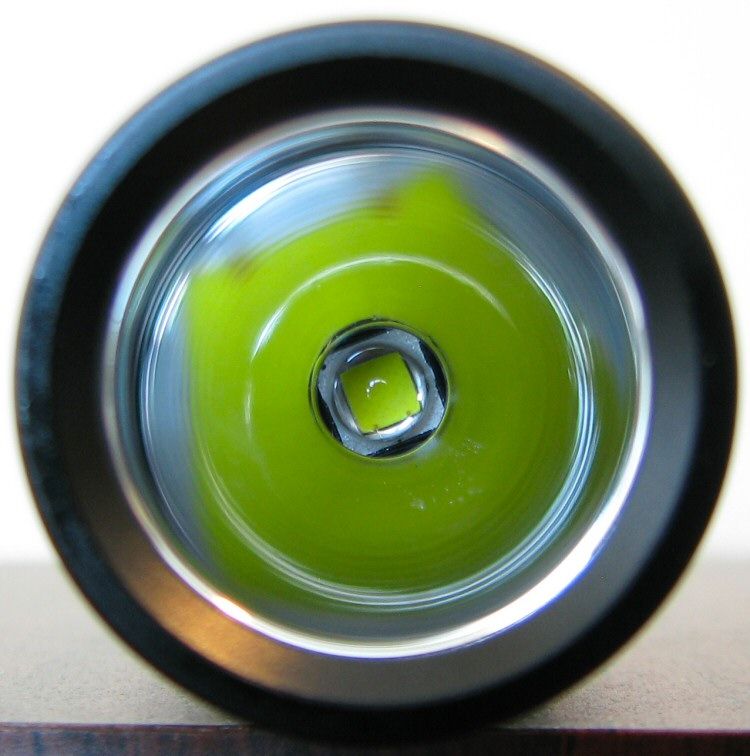
The P12 comes with a flat black aluminum bezel. The overall head is typical for this class - not very large. Reflector is smooth, and fairly deep given this size head. Coupled with the XM-L2 cool white emitter (which were well centered on my samples), I would expect a fairly typical beam pattern, but with slightly greater throw than many in this class. Scroll down for beamshots.
User Interface
There is no change to interface on the 2015 edition. As before, the P12 uses a dual-switch interface, similar to the Fenix PD35 or Thrunite TN12-2014.
Turn the light on/off by the forward tailcap switch. Lightly press and hold for momentary, click (press and release) for constant on. Click again to turn off.
To change modes, click the electronic switch in the head, while the light on. Mode sequence is Lower > Lo > Med > Hi, in repeating sequence. The light has mode memory, and returns the last level set after turning the tail switch off/on.
Press and hold the electronic switch to access a tactical Strobe mode. Press and hold again to select the next blinking mode. Mode sequence is: Strobe > Locator Beacon > SOS, in a repeating loop. A single click exits you from the blinking modes and puts you back into constant output.
Note that there is mode memory for the Strobe mode (but not the other two blinking modes). This is convenient if you are someone who likes immediate access to Strobe from Off.
The P12 also has a blue LED under the side mode-changing switch to serve as a low voltage indicator when the flashlight is On. Once the cells are below 50% power (according to Nitecore), this indicator will flash blue every 2 seconds. It will flash faster as the power capacity drops down further.
With the light turned Off, you can get a battery voltage readout by pressing and holding the side switch while simultaneously activating the tailcap switch. The blue LED will then read out the voltage in a series of flashes (e.g., Four flashes, followed by a short pause, with two more flashes would indicate a full charge of 4.2V). Note that if you click the tailswitch on (as opposed to press-hold), the light will actually turn itself on after the voltage read-out finishes.
Video:
For more information on the overall build and user interface, and direct beam/output comparison of the 2014 and 2015 editions, please see my new video overview:
As with all my videos, I recommend you have annotations turned on. I commonly update the commentary with additional information or clarifications before publicly releasing the video.
As an aside, if you want to get an instant notification for every new review that I post here on CPF, you can subscribe to my YouTube channel (the vids go public at the same time). Just mouse over my logo watermark on the top right-hand corner of the video for the subscribe feature to open up. You may need to tap or click, depending on the platform you are using to watch. :wave:
PWM/Strobe
The P12 is fully current-controlled, as before. There is no PWM, on any level.
Please note that I have updated my oscilloscope software since the earlier 2014 edition review. As such, some of the patterns may look a little different below.
As with 2014 edition, I did detect some circuit noise on my oscilloscope at the Lo and Med levels specifically, but this was completely invisible in actual use.
Lo Noise
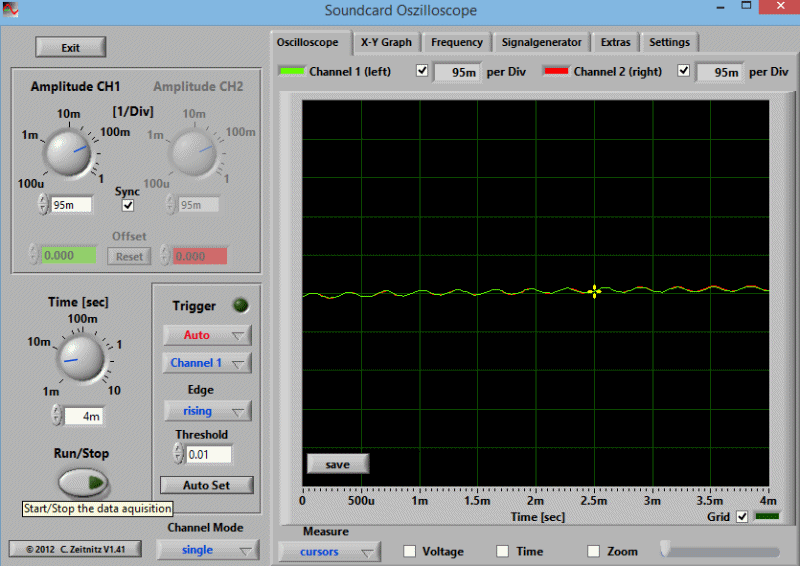
Med Noise:
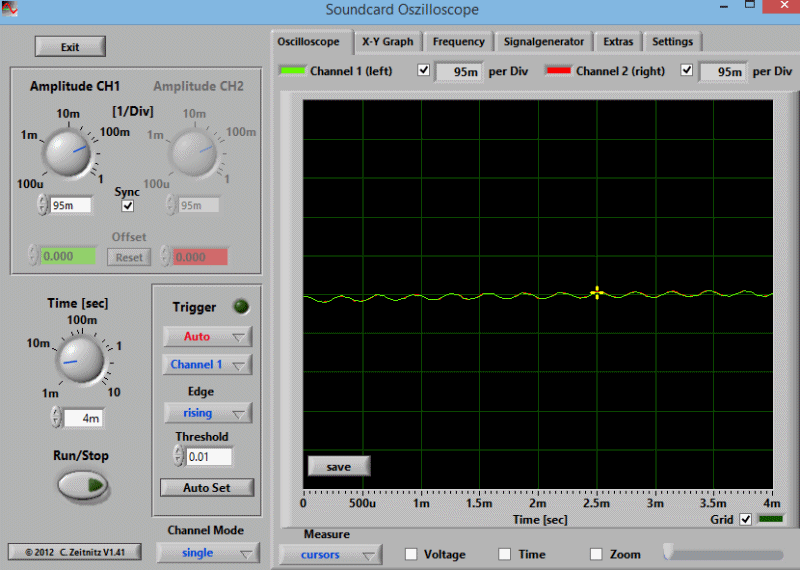
Hi:
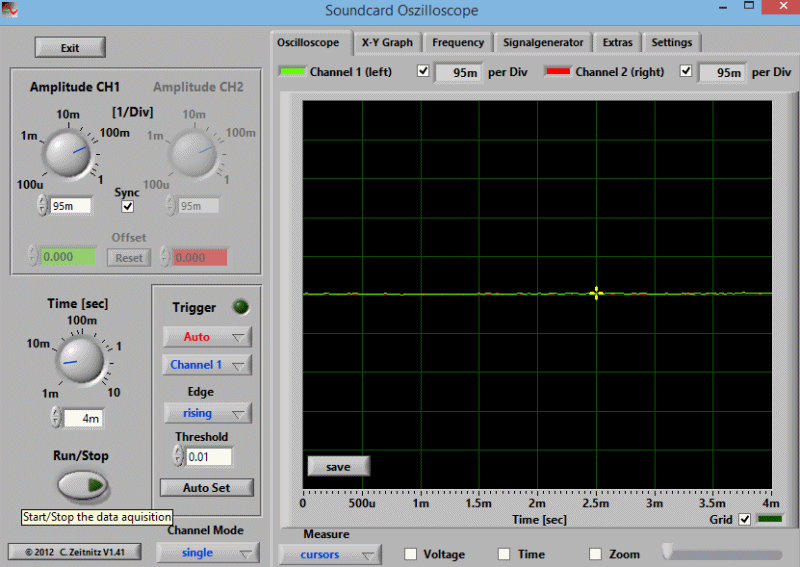
Again, consistent with my standard review policy, I report on any oscilloscope signals that I can detect in the output of a light. But I can assure you that the above patterns produce no visible effect – even when shining on a fan. The P12 remains fully "flicker-free" at all levels.
Strobe
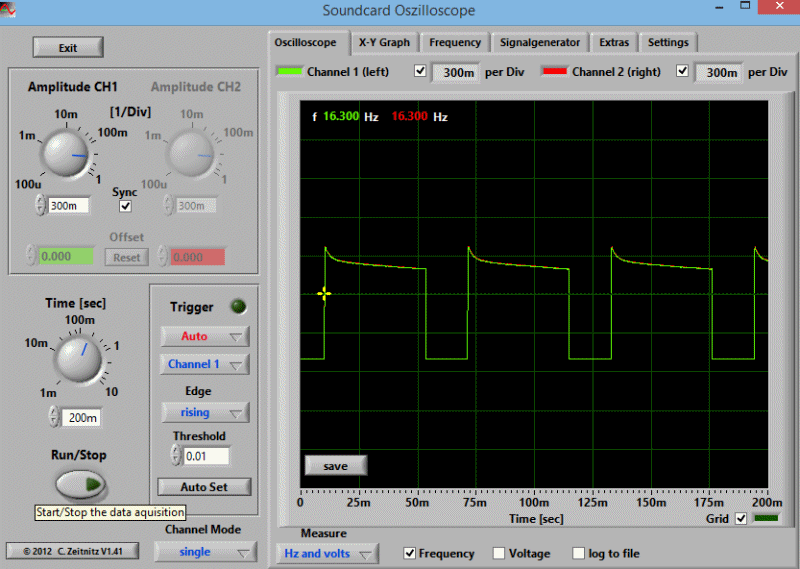
The strobe remains a very fast "tactical" strobe, at the same 16.3Hz frequency as before. Also as before, the strobe duty cycle is a little unusual, as it is only "on" a portion of the total time of each strobe cycle (i.e., most strobes are an even 50:50 on/off). But it doesn't change how disorienting it is in general terms. :green:
Beacon
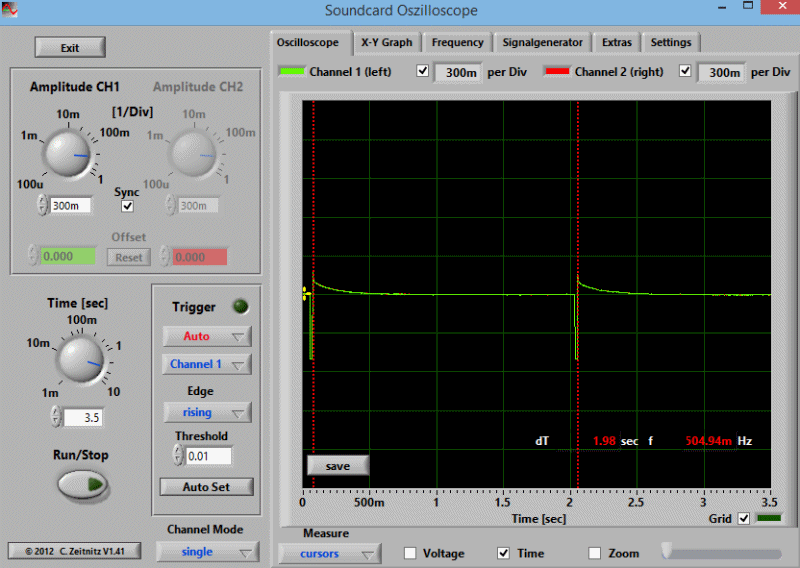
Beacon was a quick high-output flash, once every 2 secs or so.
SOS
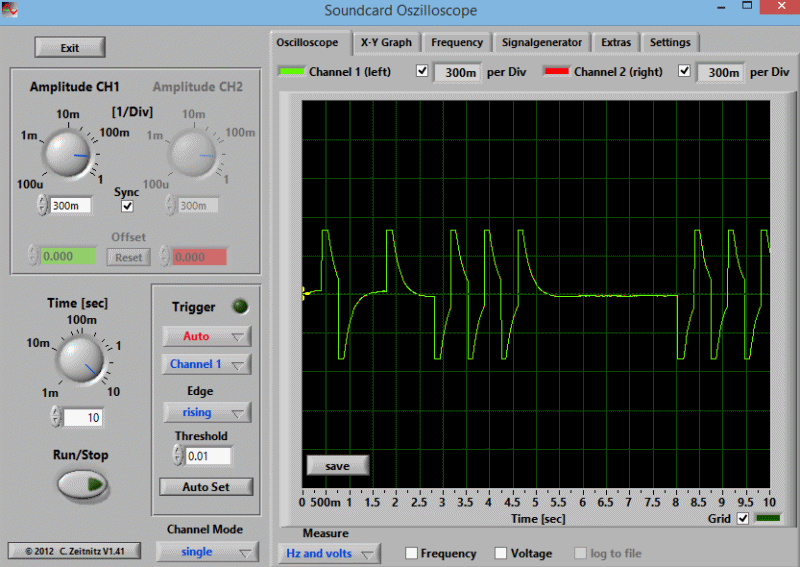
SOS remains a fairly typical SOS mode.
Beamshots:
For white-wall beamshots below, all lights are on Max output on an AW protected 18650 battery. Lights are about ~0.75 meter from a white wall (with the camera ~1.25 meters back from the wall). Automatic white balance on the camera, to minimize tint differences.
The original P12 2014 edition is simply labelled "P12" below.
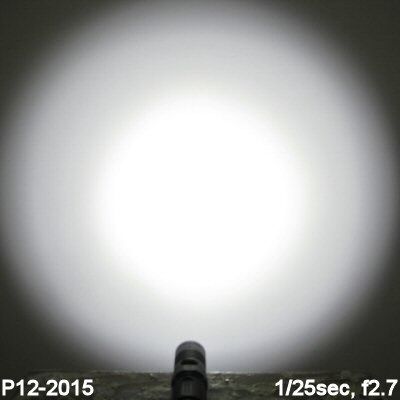
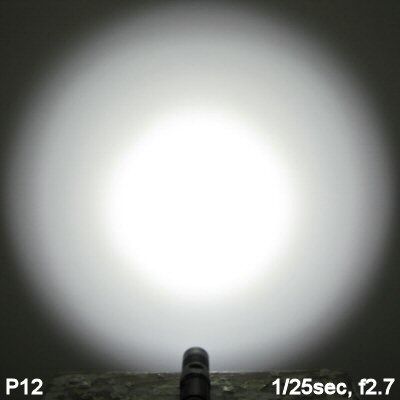
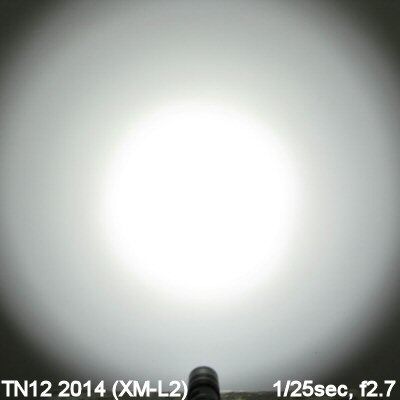
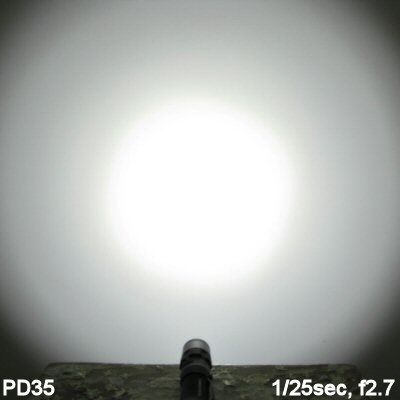
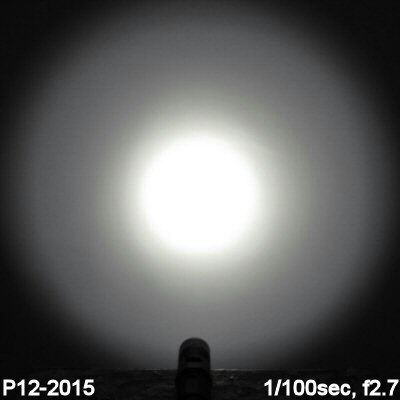
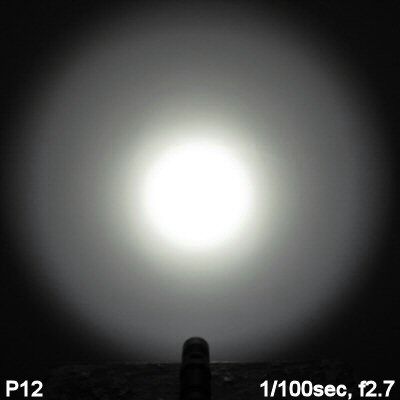
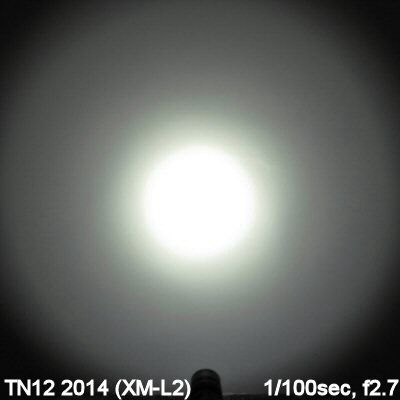
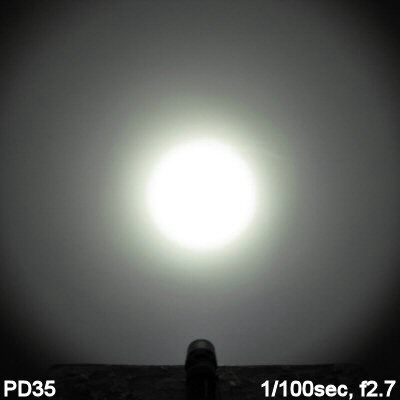
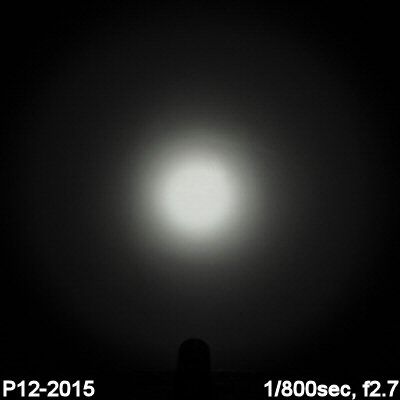
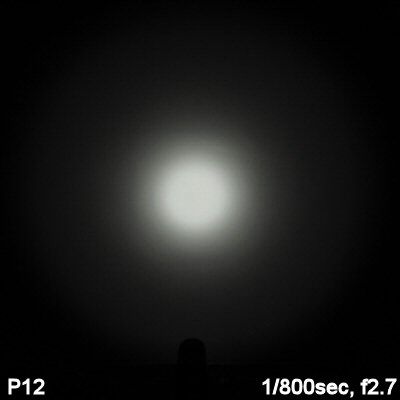
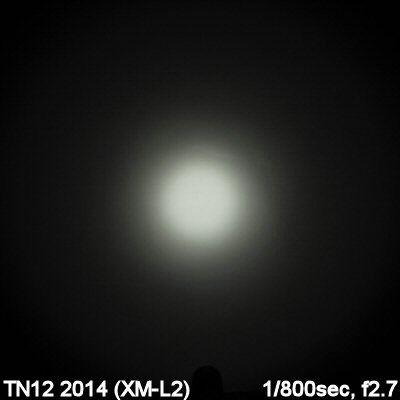
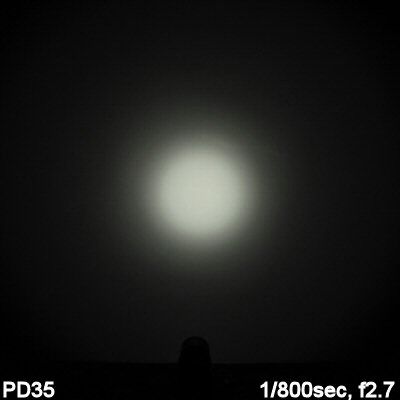
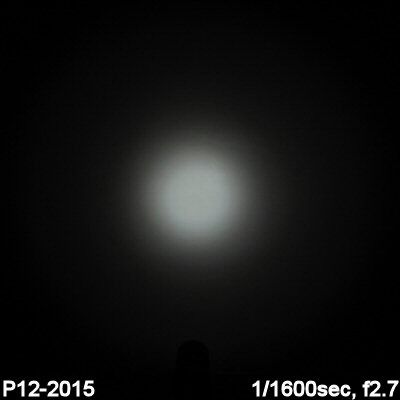
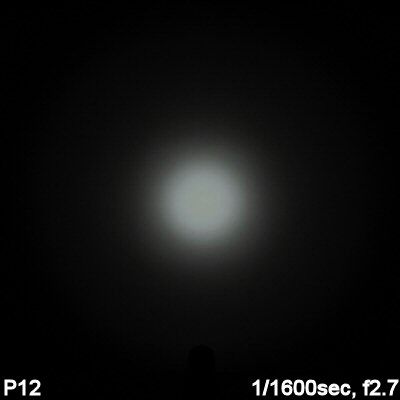
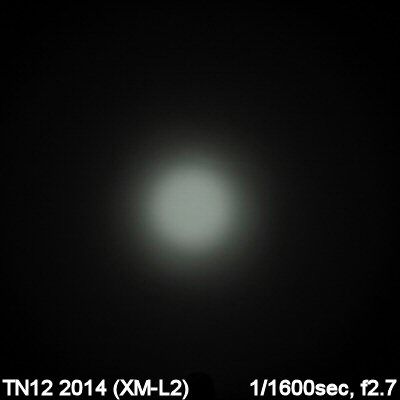
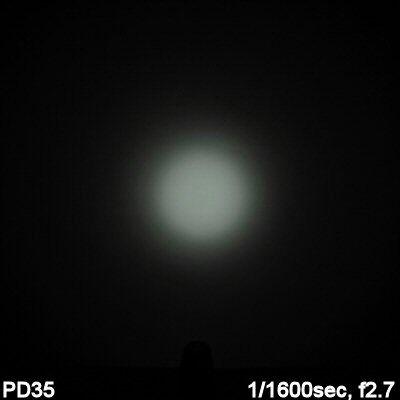
Beam pattern is about what you would expect for a light this size. Spillbeam width is slightly narrower than some recent competitors, and the P12 has excellent throw for the class (both consistent with its somewhat deeper reflector). The new 2015 edition seems to be just a touch brighter than my 2014 edition - scroll down for detailed output and throw measures.
Testing Method:
All my output numbers are relative for my home-made light box setup, as described on my flashlightreviews.ca website. You can directly compare all my relative output values from different reviews - i.e. an output value of "10" in one graph is the same as "10" in another. All runtimes are done under a cooling fan, except for any extended run Lo/Min modes (i.e. >12 hours) which are done without cooling.
I have devised a method for converting my lightbox relative output values (ROV) to estimated Lumens. See my How to convert Selfbuilt's Lightbox values to Lumens thread for more info.
Throw/Output Summary Chart:
My summary tables are reported in a manner consistent with the ANSI FL-1 standard for flashlight testing. Please see http://www.flashlightreviews.ca/FL1.htm for a discussion, and a description of all the terms used in these tables. Effective July 2012, I have updated all my Peak Intensity/Beam Distance measures with a NIST-certified Extech EA31 lightmeter (orange highlights).
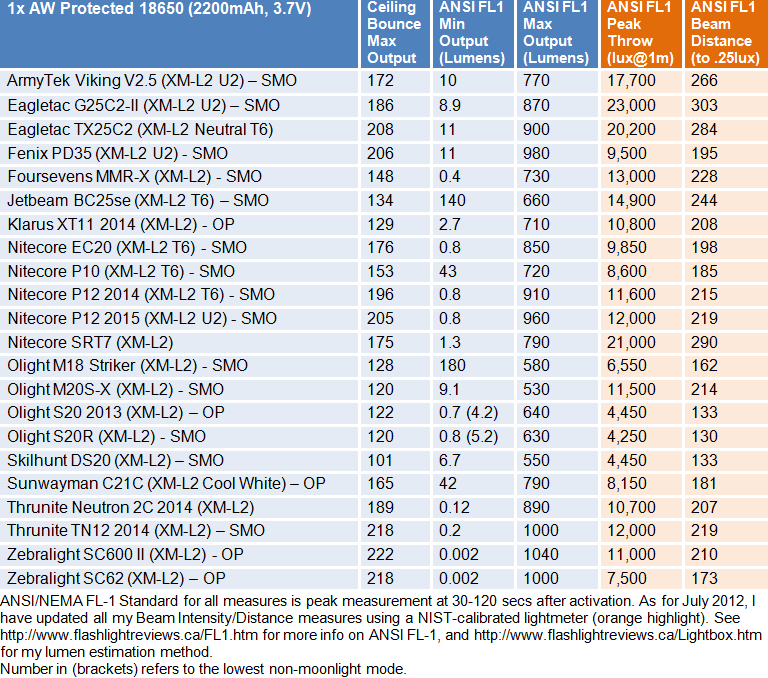
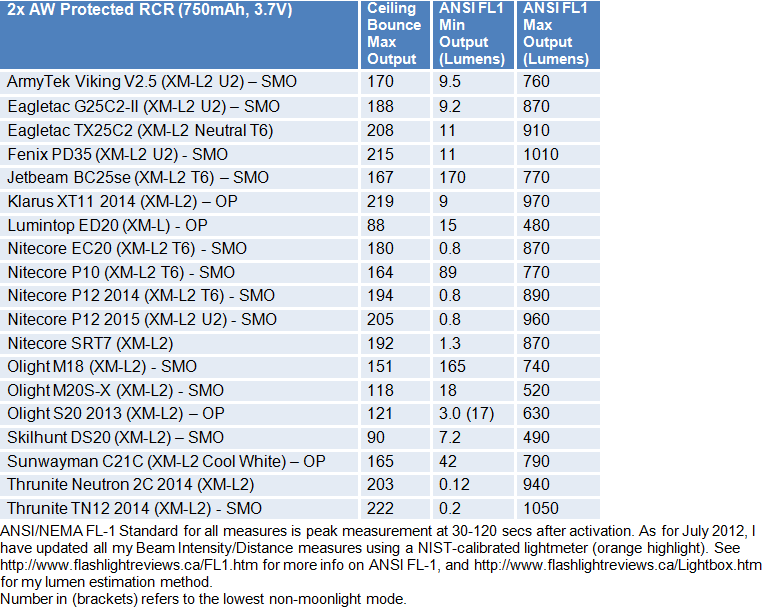
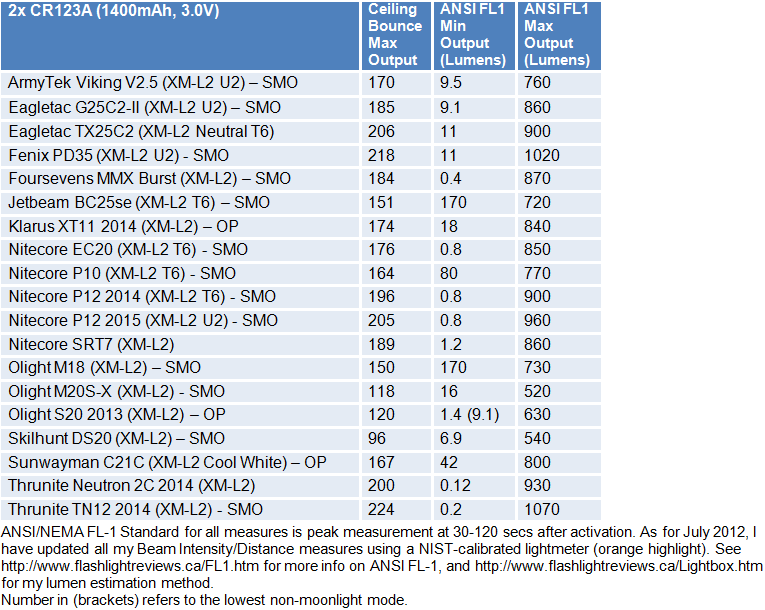
Consistent with a single output bin step, my P12 2015 sample is ~6% brighter on max than my P12 2014 sample.
Let's see how all the levels compare to the official specs, on 1x18650 in my lightbox:
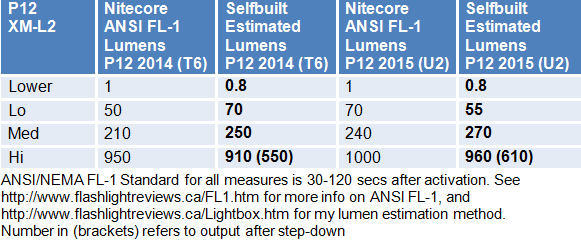
As before, I get very good concordance between my estimated lumens and Nitecore's published specs. There is not a major difference between any of the output modes of these two models, frankly. As before, I appreciate the <1 lumen "Lower" mode on the P12, as I personally like having low-level options in a general purpose light.
The mode spacing remains pretty good, although most lights of this this class would typically have an additional Hi level between the current Med and Hi outputs. On that front, note that (as before), the Hi mode of the P12 steps eventually down to an intermediate Hi level (i.e., something between the defined Med and Hi modes). See my Runtimes below for more info.
Output/Runtime Graphs:
All runtimes are done under a cooling fan. 18650 runtimes done using protected batteries based on the Panasonic NCR18650A core.
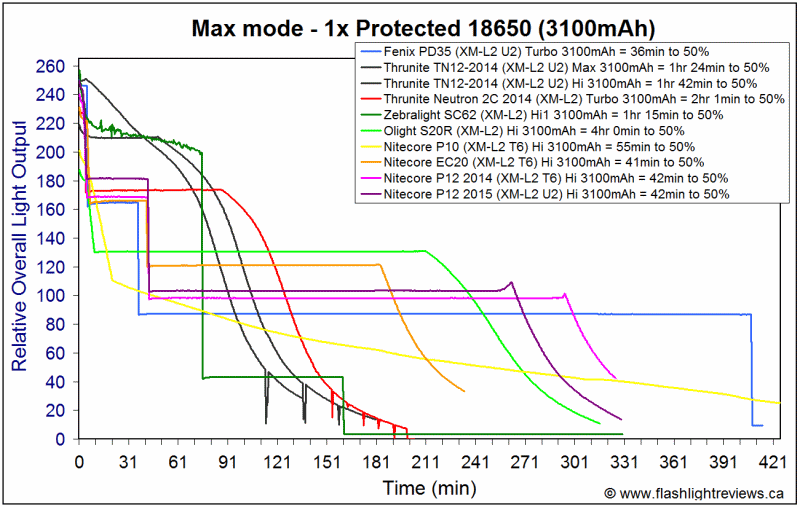
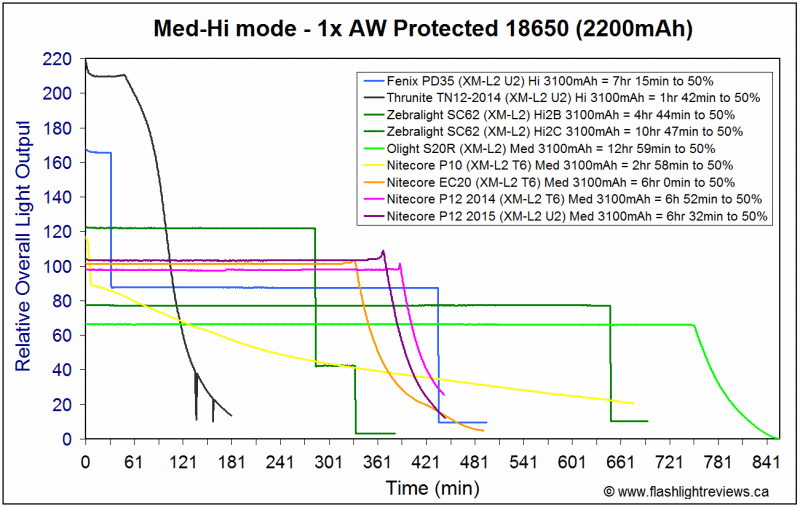
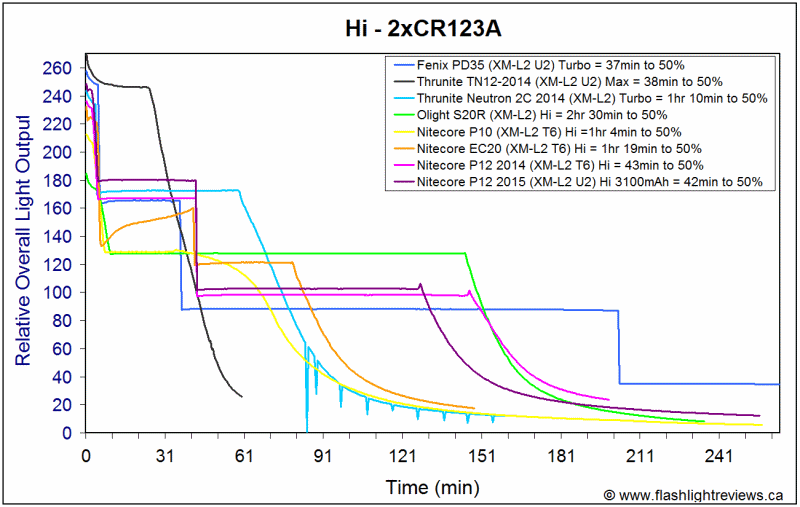
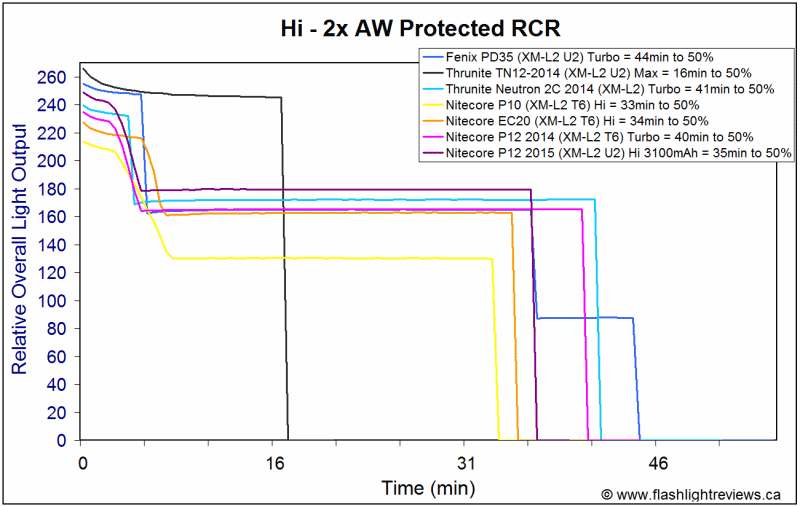
There is no real difference in runtimes above – basically, performance of the two versions is the same (except for the marginally higher output on the 2015 edition).
As before, the P12 shows very good efficiency and regulation at all levels, although there are some competing products that are even more efficient.
Potential Issues
As before, there are a series of step-downs from "Hi" on the P12, on all batteries (i.e., rapid step-down initially to an intermediate Med-Hi level, and then a subsequent step down to Med).
Mode spacing is good, although I would think adding the intermediate Med-Hi level into the regular sequence would be good idea (i.e. as a fifth selectable mode).
Preliminary Observations
Like with the EA41, the "2015 edition" of the P12 is really just an incremental step forward from the original 2014 edition. In this case, it seems to be simply an emitter upgrade (by a single output bin, from T6 to U2). As such, you would expect on average ~6-7% greater output at each level. However, depending on where any two emitters are in their bins, the practical difference between individual samples could be anywhere from ~1-13%.
Build quality remains very good, with good hand feel and overall design. I like the easy access to the tailswitch, while maintaining tailstanding – one of the best I've seen in this class. The user interface is very intuitive, with the dual physical tailcap switch and side mode-changing electronic switch. Switch feel is good on both. And the low-voltage and battery read-out features of side switch (using Nitecore's trademark blue LED) are nice additions to this class.
In terms of output modes, the P12 has a good range of constant modes - although one extra intermediate Med-Hi mode would have been nice (i.e., something like the Hi step-down level). I particularly like the <1 lumen "lower" level here - helpful if you have dark-adapted eyes. Nitecore has provided additional blinking modes as well. I personally like the Beacon mode, but would still like to see a slow signaling strobe. And for those of you who demand such things, there is mode memory for the Tactical Strobe mode here (i.e., you can set the P12 to come on that way).
Output/runtime efficiency was very good, as before, demonstrating a good constant-current circuit. The step-down pattern on Turbo was remarkably similar to the Fenix PD35. The light is fully regulated at all levels.
Beam pattern is good as well, with a reasonable balance between throw and spill. Given the fairly standard size head, there are lots of beam shaping accessories out there from a range of makers that will fit on the light.
At the end of the day, there is not really much here to compel an existing P12 user to "upgrade" (i.e., you won't even notice the output difference from the 2014 version). Of course, if given a choice for the same price, you might as well as go for the 2015 edition. But if discounts are offered on stock of the older 2014 edition, you may be able to pick up a good bargain for a negligible loss of output.
Either way, there is still a lot to here to commend the P12. As before, the P12 shows some definite additions to this class (i.e., extra blinky modes, mode memory for tactical strobe, low-voltage indicator and battery read out). Definitely a strong contender to consider. :wave:
-----
P12 2015 edition provided by Nitecore for review.

Nitecore has updated their popular P12 model to a new "2015" edition featuring a higher output bin XM-L2 emitter (from T6 to U2). The official specs have been updated to match.
How does this new 2015 model compare to the original 2014 that I reviewed a little while ago? Physically, there is no change in appearance of the light. So let's see what has changed ...



Manufacturer Reported Specifications:
(note: as always, these are simply what the manufacturer provides – scroll down to see my actual testing results).
- LED: Cree XM-L2 U2
- Uses one 18650 rechargeable battery or two CR123A batteries.
- Output/Runtime (1x18650): Hi 1000lumens / 1hr 15min – Med 240lumens / 6hr – Lo 70lumens / 28hr – Lower 1lumen / 520hr
- Output/Runtime (2xCR123A): Hi 1000lumens / 1hr – Med 240lumens / 5hr 15min – Lo 70lumens / 20hr – Lower 1lumen / 300hr
- Beam Intensity: 13,500cd
- Beam Distance: 232m
- Impact resistant to 1.5 meters
- Waterproof in accordance with IPX-8 (two meters submersible)
- Second generation 'Crystal Coating Technology' combined with 'Precision Digital Optics Technology' provide extreme reflector performance
- High efficiency circuit board provides up to 520 hours runtime on low
- Side switch interface provides one-handed operation and easy access to all functions
- Side switch features an indicator light which displays remain ing battery power (patented)
- Power indicator secondary function displays battery voltage (accurate to 0.1V)
- Intelligent memory function stores preferred brightness setting
- High-efficiency regulation circuit provides unwavering output
- Toughened ultra-clear mineral glass with anti-reflective coating
- Constructed from aero grade aluminium alloy with HAIII military grade hard-anodized finish
- Stainless steel titanium-plated clip included
- Tail stand capability
- Dimensions: Length: 139mm (5.47"), Head Diameter: 25.4mm (1"), Tail Diameter: 25.4mm (1")
- Weight: 88grams (3.10oz) (without battery)
- Accessories: Quality holster, clip, tactical ring, lanyard, spare tail cap, spare O-ring
- MSRP: ~$60




Packaging is the Nitecore's standard thin cardboard display box, with a new 2015 Edition label on the front of the box. As before, detailed specs and information are printed right on the box. Inside, included with the light are spare O-rings, spare tailswitch boot cover, removable grip ring, pocket clip, basic wrist lanyard, holster with Velcro closing flap, product inserts, warranty card, and manual.
Since light looks exactly the same as the previous 2014 edition, I will re-use the body pictures from my 2014 review below.



From left to right: AW Protected 18650 2200mAh; Fenix PD35; Nitecore P12; Eagletac TX25C2; Sunwayman V25C; Olight S20 2014; Eagletac D25LC2; Sunwayman C21C; Foursevens Quark Q123-2.
All dimensions directly measured, and given with no batteries installed:
Nitecore P12 2015: Weight: 88.7g, Length: 139.5mm, Width (bezel): 25.5mm
Nitecore P12 2014: Weight: 89.7g, Length: 139.4mm, Width (bezel): 25.4mm
Nitecore P10: Weight 82.0g, Length: 135.1mm, Width (bezel): 25.5mm
Nitecore EC20: Weight: 77.1g, Length: 129.2mm, Width (bezel): 25.4mm
Eagletac D25LC2: Weight: 50.0g, Length: 116.3mm, Width (bezel): 22.5mm
Eagletac TX25C2: Weight 93.6g, Length: 120.4mm, Width (bezel): 31.6mm
Fenix PD35: Weight: 82.7g, Length: 138.1mm, Width (bezel): 25.4mm
Thrunite TN12-2014: Weight: 80.0g, Length: 140.5mm, Width (bezel): 25.4mm
Skilhunt DS20: Weight: 53.8g, Length: 110.0mm, Width (bezel): 24.0mm
Zebralight SC600 II: Weight 79.3g, Length: 101.8mm, Width (bezel) 29.7mm
There is some very minor fluctuation is dimensions between my samples, but I expect that is just normal natural variation.





Again, the 2015 edition is physically indistinguishable from the 2014 version. As such, my comments below apply to both versions.
The P12 is a compact, yet solid little light. Anodizing is a shiny black finish, hard anodized, with no chips or damage on my sample. Body labels are bright white and clear against the black background. Knurling is of moderate aggressiveness on the body tube and tailcap. But when combined all the other grip elements (e.g., side switch cover, fins in the head, pocket clip, etc.), I would describe overall grip as very good.
The light has decent anti-roll indentations on the body, but the clip is even more helpful in that regard. Clip is supposedly titanium-plated stainless steel, and feels reasonably sturdy. There is also a bundled grip ring in the package, for cigar-grip style carry (also very effective for anti-roll).
Tailcap screw threads are standard triangular cut and anodized for lock-out at either end of the body tube. :thumbsup:
The P12 uses a forward clicky switch, but with very good tailstanding ability due to the raised side edges (suitable for lanyard attachement). Switch access by finger or thumb is good.
On/off is controlled by the physical tailcap clicky switch, but all mode switching is done by the electronic side switch in the head. The mode-changing switch in the head has pretty good feel for an electronic switch, with typical traverse. It is relatively easy to locate by feel (although could be grippier, with more visual distinctiveness).
Note that like many other Nitecore models, there is a blue LED under the mode-changing side-switch that will glow blue when the batteries are running low. It also serves as a voltage read-out function. Please see my User Interface section for a discussion.
There is a physical reverse polarity feature in the head. However, this has been updated from earlier Nitecore models and now allows "wide button top" cells to work in the light. True flat-tops (where the positive contact is below the wrapper) won't work, but all my cells with a slightly raised contact worked fine.
The body tube is wide enough to accommodate all size 18650 cells, and there seems to be plenty of room of longer cells as well.


The P12 comes with a flat black aluminum bezel. The overall head is typical for this class - not very large. Reflector is smooth, and fairly deep given this size head. Coupled with the XM-L2 cool white emitter (which were well centered on my samples), I would expect a fairly typical beam pattern, but with slightly greater throw than many in this class. Scroll down for beamshots.
User Interface
There is no change to interface on the 2015 edition. As before, the P12 uses a dual-switch interface, similar to the Fenix PD35 or Thrunite TN12-2014.
Turn the light on/off by the forward tailcap switch. Lightly press and hold for momentary, click (press and release) for constant on. Click again to turn off.
To change modes, click the electronic switch in the head, while the light on. Mode sequence is Lower > Lo > Med > Hi, in repeating sequence. The light has mode memory, and returns the last level set after turning the tail switch off/on.
Press and hold the electronic switch to access a tactical Strobe mode. Press and hold again to select the next blinking mode. Mode sequence is: Strobe > Locator Beacon > SOS, in a repeating loop. A single click exits you from the blinking modes and puts you back into constant output.
Note that there is mode memory for the Strobe mode (but not the other two blinking modes). This is convenient if you are someone who likes immediate access to Strobe from Off.
The P12 also has a blue LED under the side mode-changing switch to serve as a low voltage indicator when the flashlight is On. Once the cells are below 50% power (according to Nitecore), this indicator will flash blue every 2 seconds. It will flash faster as the power capacity drops down further.
With the light turned Off, you can get a battery voltage readout by pressing and holding the side switch while simultaneously activating the tailcap switch. The blue LED will then read out the voltage in a series of flashes (e.g., Four flashes, followed by a short pause, with two more flashes would indicate a full charge of 4.2V). Note that if you click the tailswitch on (as opposed to press-hold), the light will actually turn itself on after the voltage read-out finishes.
Video:
For more information on the overall build and user interface, and direct beam/output comparison of the 2014 and 2015 editions, please see my new video overview:
As with all my videos, I recommend you have annotations turned on. I commonly update the commentary with additional information or clarifications before publicly releasing the video.
As an aside, if you want to get an instant notification for every new review that I post here on CPF, you can subscribe to my YouTube channel (the vids go public at the same time). Just mouse over my logo watermark on the top right-hand corner of the video for the subscribe feature to open up. You may need to tap or click, depending on the platform you are using to watch. :wave:
PWM/Strobe
The P12 is fully current-controlled, as before. There is no PWM, on any level.
Please note that I have updated my oscilloscope software since the earlier 2014 edition review. As such, some of the patterns may look a little different below.
As with 2014 edition, I did detect some circuit noise on my oscilloscope at the Lo and Med levels specifically, but this was completely invisible in actual use.
Lo Noise

Med Noise:

Hi:

Again, consistent with my standard review policy, I report on any oscilloscope signals that I can detect in the output of a light. But I can assure you that the above patterns produce no visible effect – even when shining on a fan. The P12 remains fully "flicker-free" at all levels.
Strobe

The strobe remains a very fast "tactical" strobe, at the same 16.3Hz frequency as before. Also as before, the strobe duty cycle is a little unusual, as it is only "on" a portion of the total time of each strobe cycle (i.e., most strobes are an even 50:50 on/off). But it doesn't change how disorienting it is in general terms. :green:
Beacon
Beacon was a quick high-output flash, once every 2 secs or so.
SOS

SOS remains a fairly typical SOS mode.
Beamshots:
For white-wall beamshots below, all lights are on Max output on an AW protected 18650 battery. Lights are about ~0.75 meter from a white wall (with the camera ~1.25 meters back from the wall). Automatic white balance on the camera, to minimize tint differences.
The original P12 2014 edition is simply labelled "P12" below.
















Beam pattern is about what you would expect for a light this size. Spillbeam width is slightly narrower than some recent competitors, and the P12 has excellent throw for the class (both consistent with its somewhat deeper reflector). The new 2015 edition seems to be just a touch brighter than my 2014 edition - scroll down for detailed output and throw measures.
Testing Method:
All my output numbers are relative for my home-made light box setup, as described on my flashlightreviews.ca website. You can directly compare all my relative output values from different reviews - i.e. an output value of "10" in one graph is the same as "10" in another. All runtimes are done under a cooling fan, except for any extended run Lo/Min modes (i.e. >12 hours) which are done without cooling.
I have devised a method for converting my lightbox relative output values (ROV) to estimated Lumens. See my How to convert Selfbuilt's Lightbox values to Lumens thread for more info.
Throw/Output Summary Chart:
My summary tables are reported in a manner consistent with the ANSI FL-1 standard for flashlight testing. Please see http://www.flashlightreviews.ca/FL1.htm for a discussion, and a description of all the terms used in these tables. Effective July 2012, I have updated all my Peak Intensity/Beam Distance measures with a NIST-certified Extech EA31 lightmeter (orange highlights).



Consistent with a single output bin step, my P12 2015 sample is ~6% brighter on max than my P12 2014 sample.
Let's see how all the levels compare to the official specs, on 1x18650 in my lightbox:

As before, I get very good concordance between my estimated lumens and Nitecore's published specs. There is not a major difference between any of the output modes of these two models, frankly. As before, I appreciate the <1 lumen "Lower" mode on the P12, as I personally like having low-level options in a general purpose light.
The mode spacing remains pretty good, although most lights of this this class would typically have an additional Hi level between the current Med and Hi outputs. On that front, note that (as before), the Hi mode of the P12 steps eventually down to an intermediate Hi level (i.e., something between the defined Med and Hi modes). See my Runtimes below for more info.
Output/Runtime Graphs:
All runtimes are done under a cooling fan. 18650 runtimes done using protected batteries based on the Panasonic NCR18650A core.




There is no real difference in runtimes above – basically, performance of the two versions is the same (except for the marginally higher output on the 2015 edition).
As before, the P12 shows very good efficiency and regulation at all levels, although there are some competing products that are even more efficient.
Potential Issues
As before, there are a series of step-downs from "Hi" on the P12, on all batteries (i.e., rapid step-down initially to an intermediate Med-Hi level, and then a subsequent step down to Med).
Mode spacing is good, although I would think adding the intermediate Med-Hi level into the regular sequence would be good idea (i.e. as a fifth selectable mode).
Preliminary Observations
Like with the EA41, the "2015 edition" of the P12 is really just an incremental step forward from the original 2014 edition. In this case, it seems to be simply an emitter upgrade (by a single output bin, from T6 to U2). As such, you would expect on average ~6-7% greater output at each level. However, depending on where any two emitters are in their bins, the practical difference between individual samples could be anywhere from ~1-13%.
Build quality remains very good, with good hand feel and overall design. I like the easy access to the tailswitch, while maintaining tailstanding – one of the best I've seen in this class. The user interface is very intuitive, with the dual physical tailcap switch and side mode-changing electronic switch. Switch feel is good on both. And the low-voltage and battery read-out features of side switch (using Nitecore's trademark blue LED) are nice additions to this class.
In terms of output modes, the P12 has a good range of constant modes - although one extra intermediate Med-Hi mode would have been nice (i.e., something like the Hi step-down level). I particularly like the <1 lumen "lower" level here - helpful if you have dark-adapted eyes. Nitecore has provided additional blinking modes as well. I personally like the Beacon mode, but would still like to see a slow signaling strobe. And for those of you who demand such things, there is mode memory for the Tactical Strobe mode here (i.e., you can set the P12 to come on that way).
Output/runtime efficiency was very good, as before, demonstrating a good constant-current circuit. The step-down pattern on Turbo was remarkably similar to the Fenix PD35. The light is fully regulated at all levels.
Beam pattern is good as well, with a reasonable balance between throw and spill. Given the fairly standard size head, there are lots of beam shaping accessories out there from a range of makers that will fit on the light.
At the end of the day, there is not really much here to compel an existing P12 user to "upgrade" (i.e., you won't even notice the output difference from the 2014 version). Of course, if given a choice for the same price, you might as well as go for the 2015 edition. But if discounts are offered on stock of the older 2014 edition, you may be able to pick up a good bargain for a negligible loss of output.
Either way, there is still a lot to here to commend the P12. As before, the P12 shows some definite additions to this class (i.e., extra blinky modes, mode memory for tactical strobe, low-voltage indicator and battery read out). Definitely a strong contender to consider. :wave:
-----
P12 2015 edition provided by Nitecore for review.

